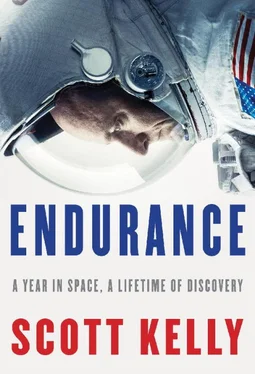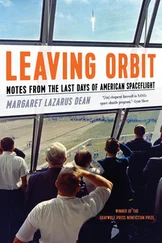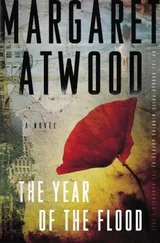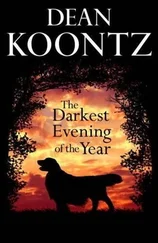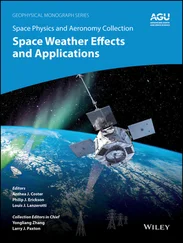Because astronauts always have to prepare for the possibility we won’t survive a mission, Mark now had to consider his responsibilities to Gabby in a new way. On his previous flight, Mark had straightened out his affairs and written a letter to be delivered to Gabby in the eventuality he didn’t come back. But now he wasn’t just Gabby’s husband, he was also her main caretaker and her main support. If he were suddenly gone, that would be disastrous in a very different way.
In all our discussions about Mark’s mission and the possibility he could die, we couldn’t help but note the irony. As astronauts, Mark and I had been confronted with the risks of flying in space. None of us could have imagined that it would be Gabby, not Mark, whose work nearly cost her her life.
—
IN FEBRUARY, Discovery came up and docked with the station on its last flight. It was funny seeing a shuttle crew come on board, as I had done myself not that long before, flying around in the Superman orientation—floating horizontally—rather than the more upright position of seasoned long-term space travelers. The new guys were bumping into everything and kicking equipment off the walls everywhere they went. The day after they arrived, I floated over to visit Discovery, the orbiter I had flown on my first flight. I remembered the last time I had been on board, December 28, 1999, climbing out that evening at the end of the flight. It seemed like a lifetime ago.
Looking around the mid-deck, I felt a wave of nostalgia for the time I’d spent there. The three remaining orbiters were remarkably similar, especially Discovery and Endeavour, which both had similar upgrades made after Columbia had been assembled. But there were differences between them that we who flew on them found unmistakable. When I had flown on Endeavour several years earlier, it still had a new-car look to it, even though it had been in service for sixteen years. At twenty-seven, Discovery was the oldest orbiter, the workhorse of the fleet on its thirty-ninth and last mission. But rather than seeming past its prime, it seemed to me like a well-loved classic with the refinement of a vintage car.
I floated up to the flight deck where the pilot, Eric Boe, was strapped into his seat running through some checklists. He greeted me and continued with his work.
“Hey, Eric, do you mind if I jump up into your seat for a minute? I just want to see how it feels.”
Eric is a sharp guy. “Your first flight was on Discovery, wasn’t it?” he asked. With a smile, he got out of the way.
I floated into the seat and strapped myself in, surveying my former office. I looked over the mass of switches, buttons, and circuit breakers that controlled the many complex systems I had been responsible for so many years ago. I knew I could fly her right now if I had the chance. I remembered sitting in this seat, and my former self seemed so young and inexperienced compared to where I was now, having spent so much more time in space. Little did I know what the future still had in store for me.
The crew of the Discovery mission did a few spacewalks, and one of them involved a Japanese payload called “Message in a Bottle.” It wasn’t an experiment but simply a glass bottle that Al Drew opened at a certain point in the spacewalk to “let space in.” Once the glass bottle returned to Earth, it would be displayed in museums throughout Japan in order to raise children’s interest in spaceflight (personally, I was skeptical about how excited children would get about an empty glass bottle). After the spacewalk was over and the bottle was back in the station, the Japanese control center wanted to know whether I had “safed” the bottle (I was supposed to tape the lid closed to make sure it wasn’t accidentally opened). I was busy doing a number of things, but they kept pestering me about it, until I finally got on the Space to Ground channel and said, “Message in a Bottle is on Discovery, and I opened it to make sure there was nothing inside.” There was a long pause. Then I said, “Just kidding.”
Shortly after Discovery and its crew returned to Earth, it would have its engines removed and would be sent to the Smithsonian’s National Air and Space Museum in Washington, D.C., to become a permanent display. Discovery had left Earth more times than any spacecraft in history, a record of distinction that I expect it to keep for a long time to come.
Sasha, Oleg, and I were scheduled to return to Earth on March 16, 2011. Never having experienced reentry on the Soyuz, I was curious what it would be like. For some strange reason that I still haven’t quite figured out, people didn’t talk about the experience of landing in the Soyuz as much as we did with the space shuttle. It might partly be because, until recently, the astronauts who flew on Soyuz were not former test pilots and so maybe lacked the curiosity bordering on obsessive interest in the performance of spacecraft that shuttle pilots had. I had been given a range of different impressions by different people—that it would be terrifying, that it would be fine, and that it would actually be fun, like Mr. Toad’s Wild Ride at Disney World.
That day everyone was concerned about the weather, because there were blizzard conditions at the landing site. Our capsule smacked into the hard frozen surface of the desert steppes of Kazakhstan, bounced around, tipped over, then was dragged a hundred yards by the parachute. I’ve never been in a car accident that ended in multiple rollovers, but I imagine that landing in the Soyuz that day felt a lot like that—violently jarring. But I found it exhilarating.
Eventually, the rescue forces corralled the parachute and knocked it down before it could drag us any farther. Not long after, the hatch opened and the blizzard blew into the capsule—the first fresh air I had smelled in six months, incredibly refreshing. It was a sensation I’ll never forget.
—
A FEW DAYS AFTER I returned to Earth, Amiko and I went to visit Gabby at TIRR Memorial Hermann, where she was being treated. I was shocked at first by how different she looked. She was in a wheelchair and was wearing a helmet to protect her head where a piece of her skull had been removed to allow her brain to swell. Her hair was short—it had been shaved for brain surgery—and her face looked different. It took me a moment to process the enormity of what had happened to her. When I heard she had been shot, I had understood intellectually what that meant. But it was another thing entirely to see my vivacious sister-in-law in such a different state—not only physically changed but unable to speak as she once had. Sometimes Gabby would get a look on her face as if she had something to say, and when we all looked at her and paused, she would say, simply, “Chicken.” Then she’d roll her eyes at herself—that wasn’t what she wanted to say!—and try again.
“Chicken.”
I could see how frustrating it was for Gabby, who used to make speeches to thousands of people that inspired them and won their votes. Mark explained that she had aphasia, a communication disorder that made it hard for her to speak, though her ability to comprehend language, her intelligence, and, most important, her personality remained unaffected. She understood everything we said to her, but putting her own thoughts into words was extremely challenging.
We had dinner together at the hospital, and as the visit went on I could see Gabby’s warmth and her sense of humor. Later, Amiko and I talked about how Gabby was doing, and Amiko said she thought Gabby looked great considering how recent her injury was. Amiko reminded me how long it had taken her own sister to walk, to speak, to regain aspects of her personality after sustaining a traumatic brain injury in a car accident. Amiko didn’t want to be overoptimistic, but she knew from experience that people could make huge strides after being in terrible shape. Gabby was still very much herself, and that was a promising indication for her recovery.
Читать дальше
